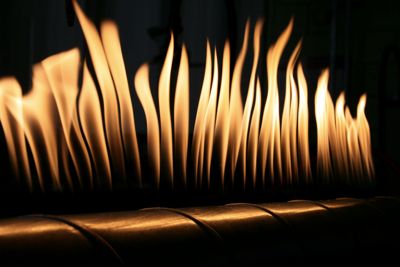A magazine where the digital world meets the real world.
On the web
- Home
- Browse by date
- Browse by topic
- Enter the maze
- Follow our blog
- Follow us on Twitter
- Resources for teachers
- Subscribe
In print
What is cs4fn?
- About us
- Contact us
- Partners
- Privacy and cookies
- Copyright and contributions
- Links to other fun sites
- Complete our questionnaire, give us feedback
Search:
Rubens' tube: Sound Sculpting with fire
Rubens' tube is a a six-foot tube with flames pouring out, dancing in response to sound. Sound has never been so hot.
The normal way to visualise sound is using an EQ meter. It is just a sound meter with bars of lights driven by the sounds. Each bar is linked to ranges of frequencies (essentially groups of notes). The more energy from those frequencies in a sound the more of the lights in the bar that light up.
Ruben's tube does a similar thing. A direct, physical reaction to sound is created by placing a loudspeaker at one end of a horizontal gas-filled tube. Gas comes out of 200 holes in the tube. With no sound it would come out of each hole at the same rate, but sound from the speaker creates standing waves down the tube. They are just waves that stay in the same place. It's a bit like being on a beach where the waves don't rush towards the shore but all just stay put. Now imagine the waves are in a tube. Where the crests are, more water has to compress into the same space than where the troughs are. Having a standing wave in a tube means the pressure is greatest where the crests of the wave are, and least in the troughs. The greater the pressure, the higher the flame is forced out at that point. There's no digital trickery involved, it's driven entirely by the physics of acoustic waves in tubes. The effect is that 200 flames dance around in response to changing sounds made into a microphone. It's an EQ meter made out of a gas fire!



